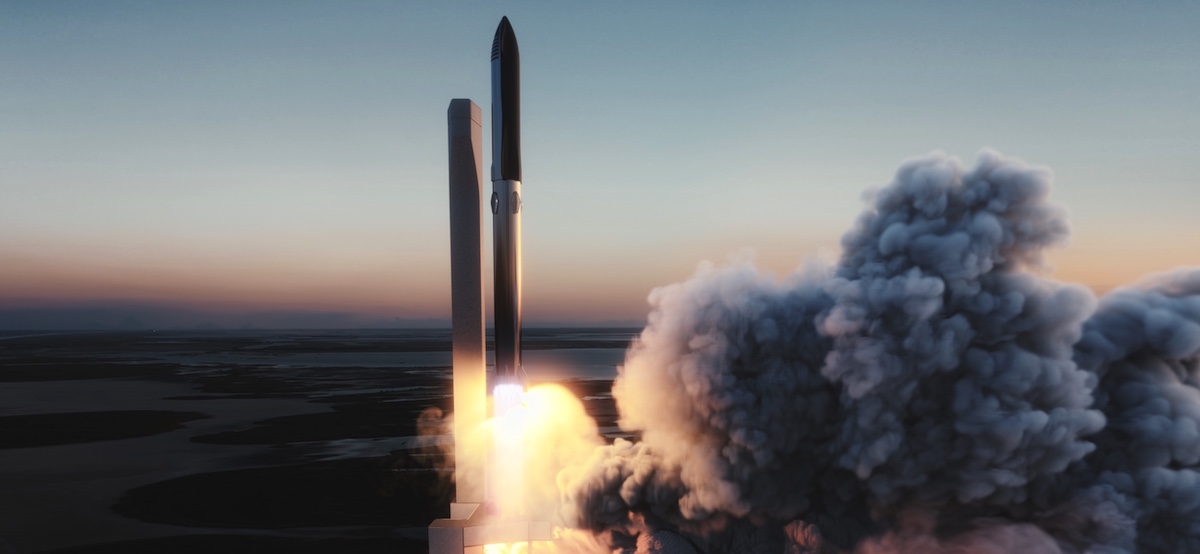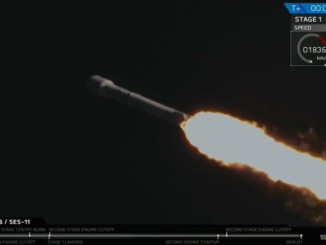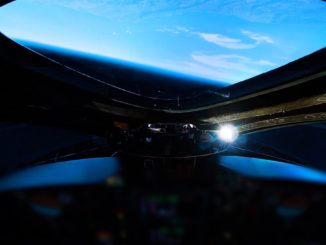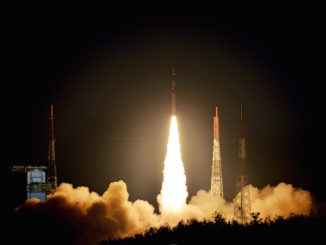
SpaceX has revealed the flight plan for the first orbital test launch of the company’s huge stainless steel Starship rocket, a 90-minute, around-the-world mission that will originate from South Texas and culminate with a controlled re-entry and splashdown in the Pacific Ocean near Hawaii.
SpaceX included an exhibit outlining the flight plan in a filing posted on the Federal Communications Commission’s website Thursday.
The test flight — without any passengers on-board — will take off from SpaceX’s Starship development facility at Boca Chica Beach in South Texas, just north of the U.S.-Mexico border. The Starship launch site, which SpaceX calls Starbase, is the same location where technicians are rapidly building new prototpes for the giant next-generation rocket.
When fully assembled, the gigantic reusable rocket will stand nearly 400 feet (120 meters) tall, making the Starship stack the largest launcher ever built.
The booster stage, called the Super Heavy, will have as many as 28 methane-burning Raptor engines on operational flights, producing some 16 million pounds of thrust, twice the power of NASA’s Apollo-era Saturn 5 rocket. Six Raptor engines will be fixed to the bottom of the rocket’s upper stage, which is itself also named the Starship.
The Starship vehicle doubles as an upper stage and a refillable transporter to ferry people and cargo through space to destinations in Earth orbit, the moon, Mars, and other distant locations.
SpaceX is developing the Starship vehicle as a fully reusable launch and space transportation system capable of ferrying more than 100 metric tons of cargo into low Earth orbit, more than any other rocket in the world.
During an orbital launch attempt, a reusable Super Heavy first stage booster will detach from the Starship and come back to Earth for a vertical landing. Eventually, SpaceX wants to use catcher arms on the launch tower to capture the descending first stage, making it easier to configure and refuel for another mission.
The Starship will continue into orbit and deploy its payloads or travel to its deep space destination, and finally return to Earth to be flown again.
The Starship’s first orbital test flight, though audacious in scale, will aim to prove out the rocket’s basic launch and re-entry capabilities without fully testing out the complicated landing and recovery systems, according to SpaceX’s filing with the FCC.

The rocket’s Super Heavy booster will fire its cluster of up to 28 Raptor engines for around 2 minute, 49 seconds, on a track toward the east from the Starbase launch site.
About two seconds later, the 230-foot-tall (70-meter) Super Heavy booster will jettison to begin a descent to a landing in the Gulf of Mexico around 8 minutes, 15 seconds, after launch. The giant booster will aim to land about 12 miles, (20 kilometers) from shore, according to SpaceX.
Meanwhile, the Starship orbital stage will ignite its Raptor engines at T+plus 3 minutes, 56 seconds, and accelerate into orbit, heading east over the Gulf of Mexico and following a track passing between South Florida and Cuba. Cutoff of the Raptor engines is expected about 8 minutes, 41 seconds, into the mission, SpaceX said, once the rocket achieves the required orbital velocity of around 17,000 mph (more than 27,000 kilometers per hour)
“The Orbital Starship will continue on flying between the Florida Straits. It will achieve orbit until performing a powered, targeted landing approximately 100 kilometers (about 62 miles) off the northwest coast of Kauai in a soft ocean landing,” SpaceX said.
The entire flight — from liftoff in Texas to splashdown near Hawaii — will last around 90 minutes.
“SpaceX intends to collect as much data as possible during flight to quantify entry dynamics and better understand what the vehicle experiences in a flight regime that is extremely difficult to accurately predict or replicate computationally,” SpaceX said. “This data will anchor any changes in vehicle design or CONOPs (concept of operations) after the first flight and build better models for us to use in our internal simulations.”

The company did not identify a target date for the Starship program’s first orbital test launch, but SpaceX chief executive Elon Musk has said the Starship’s first shot into space could happen before the end of the year.
SpaceX’s request for authority from the FCC to operate communications equipment on the orbital Starship test flight suggests the company expects the demonstration mission to occur some time between June 20 and Dec. 20.
The first Starship orbital test flight, which Musk suggested earlier this year might happen as soon as July, will follow a series of ongoing atmospheric flights intended to validate the rocket’s performance at relatively low altitudes.
The five Starship prototypes launched since December have each used three Raptor engines to power the 16-story test rockets to altitudes of more than 30,000 feet (about 10 kilometers) over South Texas. Four test rockets exploded during or soon after landing, but the most recent Starship prototype — Serial No. 15 — nailed its vertical, propulsive touchdown back at the Starbase facility.
The Starship stage, like the Super Heavy booster and SpaceX’s partially reusable Falcon 9 rocket currently in operation, will use variable thrust from its main engines to slow down for landing.

SpaceX plans more atmospheric test flights of Starship prototypes to fine-tune the rocket’s takeoff and landing. The company also plans a first “hop” test of a full-size Super Heavy booster, presumably before pressing ahead with an orbital launch attempt.
Engineers have tested coupon samples of heat shield material on the Starship’s stainless steel skin, but the orbital-class rocket will require a more extensive thermal barrier to withstand the super-hot temperatures of atmospheric re-entry.
The SN15 prototype that successfully launched and landed May 5 debuted several upgrades to the Starship rocket. The changes “will allow more speed and efficiency throughout production and flight,” SpaceX said.
The upgrades on SN15 include “a new enhanced avionics suite, updated propellant architecture in the aft skirt, and a new Raptor engine design and configuration,” SpaceX said.
The next jump in capability for the Starship rocket will come with SN20, which will be outfitted for an orbital test flight.
Musk tweeted earlier this year that the Super Heavy/Starship combination will initially have a high probability of achieving a successful launch into orbit, but it will likely take many attempts before SpaceX perfects the Starship’s re-entry and landing maneuvers from orbit.
Last month, SpaceX won a $2.9 billion contract from NASA to develop a derivative of the Starship vehicle to land astronauts on the Moon through the space agency’s Artemis program. SpaceX bested bids from Blue Origin and Dynetics to win the contract for NASA’s next human-rated lunar lander.
According to NASA’s plans, astronauts will depart Earth on the agency’s government-owned Space Launch System rocket and Orion crew capsule, then rendezvous with a Starship pre-positioned in lunar orbit. The Starship would launch from Earth without anyone on-board.
After landing on the moon, the astronauts will exit the Starship and ride an elevator down to the surface. Once their work is complete, the crew members will launch on the Starship back into lunar orbit, meet up with the Orion capsule, and return to Earth.
Last month, SpaceX won a $2.9 billion contract from NASA to develop a derivative of the Starship vehicle to land astronauts on the moon through the space agency’s Artemis program. SpaceX bested bids from Blue Origin and Dynetics to win the contract for NASA’s next human-rated lunar lander.
According to NASA’s plans, astronauts will depart Earth on the agency’s government-owned Space Launch System rocket and Orion crew capsule, then rendezvous with a Starship pre-positioned in lunar orbit. The Starship would launch from Earth without anyone on-board.
After landing on the moon, the astronauts will exit the Starship and ride an elevator down to the surface. Once their work is complete, the crew members will launch on the Starship back into lunar orbit, meet up with the Orion capsule, and return to Earth.
SpaceX has succeeded in cutting launch costs with the Falcon 9 rocket, which has a reusable first stage and payload shroud. But neither part is rapidly reusable, and the Falcon 9’s second stage is brand new for every mission.
“With Starship, we’ll hopefully reuse the whole thing,” Musk said last month. “This is a hard problem for rockets, that’s for sure. It’s taken us, we’re like 19 years in now. I think the Starship design can work. It’s just, it’s a hard thing to solve, and the support of NASA is very much appreciated in this regard. I think it’s going to work.”
Musk eventually wants to have a fleet of ocean-going platforms to recover and re-launch Super Heavy boosters and Starship rockets.
“It’s intended to be such that the booster can be used, I don’t know, a dozen times a day, basically every couple of hours,” Musk said in an X PRIZE webcast last month. “And that mostly is about reloading propellant and mounting the ship. and then the ship can probably be used, in theory, every three hours … But certainly every, say, six to nine hours. We’ll call it twice a day for the ship. And we’ll make more ships than there are boosters.”
SpaceX officials have suggested that Starships could be tasked with high-speed point-to-point intercontinental travel on Earth.
“Once we have the floating space platforms, we can position them such that the ship can come back in a single orbit,” Musk said. “So then it can be, let’s say we have three ship launches per day, that’s 1,000 flights a year, each with 100 to 150 tonnes of payload to orbit.”
“I’d say it’s only recently though that I feel that full and rapid reusability can be accomplished,” Musk said. “I wasn’t sure for a long time, but I am sure now.”
Email the author.
Follow Stephen Clark on Twitter: @StephenClark1.



